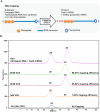Application of microfluidic chip electrophoresis for high-throughput nucleic acid fluorescence fragment analysis assays
- PMID: 36733401
- PMCID: PMC9887644
- DOI: 10.1093/nargab/lqad011
Application of microfluidic chip electrophoresis for high-throughput nucleic acid fluorescence fragment analysis assays
Abstract
Nucleic acid fragment analysis via separation and detection are routine operations in molecular biology. However, analysis of small single-stranded nucleic acid fragments (<100nt) is challenging and mainly limited to labor-intensive polyacrylamide gel electrophoresis or high-cost capillary electrophoresis methods. Here we report an alternative method, a microfluidic chip electrophoresis system that provides a size resolution of 5nt and a detection time of one minute per sample of fluorescence-labeled DNA/RNA fragments. The feasibility of this system was evaluated by quantifying CRISPR-Cas9 cleavage efficiency and the detection resolution was evaluated by analyzing ssDNA/RNA adenylation and phosphorylation. We employed this system to study the RNA capping efficiency and double-stranded DNA unwinding efficiency in isothermal amplification as two examples for assay design and evaluation. The microfluidic chip electrophoresis system provides a rapid, sensitive, and high-throughput fluorescence fragment analysis (FFA), and can be applied for enzyme characterization, reaction optimization, and product quality control in various molecular biology processes.
© The Author(s) 2023. Published by Oxford University Press on behalf of NAR Genomics and Bioinformatics.
Figures



Similar articles
-
[Research progress on analysis of human papillomavirus by microchip capillary electrophoresis].Se Pu. 2020 Oct 8;38(10):1179-1188. doi: 10.3724/SP.J.1123.2020.05016. Se Pu. 2020. PMID: 34213114 Review. Chinese.
-
Adapting capillary gel electrophoresis as a sensitive, high-throughput method to accelerate characterization of nucleic acid metabolic enzymes.Nucleic Acids Res. 2016 Jan 29;44(2):e15. doi: 10.1093/nar/gkv899. Epub 2015 Sep 13. Nucleic Acids Res. 2016. PMID: 26365239 Free PMC article.
-
Naked-eye detection of site-specific ssRNA and ssDNA using PAMmer-assisted CRISPR/Cas9 coupling with exponential amplification reaction.Talanta. 2021 Oct 1;233:122554. doi: 10.1016/j.talanta.2021.122554. Epub 2021 Jun 8. Talanta. 2021. PMID: 34215057
-
Integrated microfluidic electrophoresis system for analysis of genetic materials using signal amplification methods.Anal Chem. 2002 Feb 15;74(4):725-33. doi: 10.1021/ac010874j. Anal Chem. 2002. PMID: 11866051
-
Microfluidic chip electrophoresis for biochemical analysis.J Sep Sci. 2020 Jan;43(1):258-270. doi: 10.1002/jssc.201900758. Epub 2019 Nov 12. J Sep Sci. 2020. PMID: 31654552 Review.
Cited by
-
Analytical Methods to Evaluate RNA Circularization Efficiency.Electrophoresis. 2024 Nov;45(21-22):2005-2011. doi: 10.1002/elps.202400067. Epub 2024 Sep 30. Electrophoresis. 2024. PMID: 39345227 Free PMC article.
References
-
- Wong K.H., Campbell K.L. Factors that affect use of intercalating dyes such as PicoGreen, SYBR Green I, Syto-13 and Syto-82 in DNA assays. Biol. Reprod. 2011; 85:725–725.
-
- Barril P., Nates S. Introduction to agarose and polyacrylamide gel electrophoresis matrices with respect to their detection sensitivities. Gel Electrophoresis - Principles and Basics. 2012; InTech.
LinkOut - more resources
Full Text Sources

